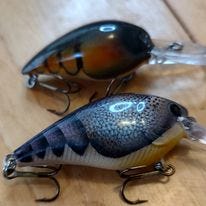Why Are Crankbaits So Effective for Smallies in the Fall?
Crankbaits are one of the most effective presentations for Smallmouth in the Fall throughout our regional river systems for several reasons:
Mimicking Baitfish Behavior: In the fall, many species of baitfish, such as shad and minnows, become more active and migrate towards shallower water in preparation for the winter. Crankbaits, with their realistic swimming action and appearance, closely mimic the behavior of these baitfish. Bass, including both largemouth and smallmouth bass, are actively feeding on these baitfish during this time, and crankbaits provide an enticing imitation.
Temperature Drop: As the water temperature begins to drop in the fall, it triggers changes in the behavior of both bass and their prey. Cooler water can make bass more active and willing to chase down prey, and crankbaits, with their fast retrieval speeds, are effective at triggering strikes from these more active bass. Crankbaits that mirror bait fish are often the most productive patterns sets especially in systems without crawdad density.
Covering Water: Crankbaits are excellent lures for covering a large area of water quickly. In the fall, bass may be scattered and not concentrated in specific areas. Crankbaits allow anglers to explore different depths and structures efficiently, increasing the chances of encountering feeding bass.
Vibration and Noise: Crankbaits generate vibrations and noise as they wobble and rattle through the water. This can be especially appealing to bass in murky or stained water conditions, which are common in the fall due to increased runoff and falling leaves. The sound and vibration produced by crankbaits can help bass locate and strike the lure.
Bumping Structure: Many river systems have submerged structure such as rocks, logs, and fallen trees. Crankbaits can be retrieved to bump or deflect off these structures, which often triggers a reaction strike from bass that are using these structures for cover and ambush points.
Variety of Depths: Crankbaits come in various diving depths, allowing anglers to target bass at different depths in the water column. This versatility is crucial in the fall when bass may be found at various depths as they follow baitfish.
Versatility: Crankbaits come in different shapes, sizes, and colors, which can be matched to the local forage and water conditions. This versatility allows anglers to adapt to changing conditions and the preferences of the fish.
Crankbaits ,in particular , squarebills are effective in the Fall in river systems because they imitate the behavior of baitfish, cover a lot of water quickly, create noise and vibration, and can be used at various depths. Their ability to trigger reaction strikes makes them a popular choice among anglers targeting bass during the Fall feeding frenzy.
Crankbaits also become a transition bait as Smallmouth move from summer haunts to where they will spend the Fall until move to winter homes. Smallies begin to migrate or “reposition” as the water temps begin to drop from the summer levels and the days begin to shortened in terms of full sun as well as much cooler overnight temps.
One aspect that is important to identify is the move by Smallies to kore day time feeding patterns over overnight patterns of summer. The high heat of summer not only aromatically but the water temps forces bass to feed more during the overnight during the dog days of summer especially if the water levels are lower than normal but as water temps cool down smallies will feed more into the late mornings even as the sun rises.
The recent spawn of sunfish family species or bluegill/crappie as well as shad from the late summer provides ample forage for smallies which is why often the best course of action to to downsize bait profiles to match the size of the recent spawners of summer.
Let’s talk Crawdads/Crayfish—
This year we have seen more density of craw in the tribs/creeks of river systems like the Upper Potomac and Susquehanna than typical and as a result less density seemingly in the main river stretches where we normally see a ton a crawdads.
I visibly saw more craw density this season in the Monocacy River and Antietam Creek than years past which I believe is why there has been greater smallie activity and increased catch rates compared to the main Potomac River during the low level periods of water depth.
Crayfish behavior in river systems during the fall months undergoes various changes in response to environmental cues, primarily driven by temperature, water levels, and their life cycle. Here's how crayfish typically behave in the fall:
Activity Levels:
Increased Activity: As the water temperature begins to cool in the fall, crayfish often become more active. Cooler water temperatures can stimulate their metabolism, making them more mobile and aggressive in their search for food and shelter.
Feeding Patterns:
Foraging for Food: Crayfish are omnivorous and scavengers, feeding on a variety of aquatic vegetation, insects, small fish, and detritus. In the fall, they intensify their foraging efforts to build up fat reserves for the winter months when food may become scarcer.
Reproduction:
Mating and Egg-Laying: Crayfish typically mate and lay eggs in the spring and early summer. By the fall, many juvenile crayfish have reached a size where they can fend for themselves. Adult crayfish may continue to protect their young until they are independent, but the focus on reproduction is reduced in the fall.
Shelter and Burrowing:
Preparing for Winter: As the weather cools further in the late fall, crayfish begin to prepare for the winter months. They may burrow deeper into the substrate to avoid freezing temperatures and to find stable, insulated shelter. This behavior helps them survive the winter in a semi-dormant state.
Migration:
Downstream Movement: Some crayfish species exhibit downstream movement in the fall. This behavior is often related to reproduction. Female crayfish may migrate downstream to release their eggs into the water, where the eggs attach to their swimmerets until they hatch.
Habitat Selection:
Seeking Cover: Crayfish are known for seeking shelter under rocks, logs, and submerged vegetation. In the fall, they may be more active in searching for suitable hiding spots as vegetation dies back, and water levels may change due to seasonal variations.
Predation Risk: As other aquatic creatures, including fish like bass, become more active and aggressive in the fall, crayfish are at greater risk of predation. They may become more cautious and rely on their protective coloration to blend into their surroundings.
It's important to note that crayfish behavior can vary depending on the species, local environmental conditions, and the specific river system. In general, they are an essential part of the river ecosystem and play a crucial role in nutrient cycling and serving as prey for various fish species. Understanding crayfish behavior in the fall can be valuable for anglers as smallie will feed up on raw for as long as they can to fatten up for the colder winter months ahead.
Custom Baitmakers featured above:
Lake’s Edge Lures https://www.facebook.com/lakesedgelures
Willamette Weapon Lures https://www.facebook.com/Willametteweaponcustomlures
Fish It Middle Tennessee https://www.facebook.com/profile.php?id=100083097382685
Tiger Crankbaits https://www.facebook.com/tigercrankbaits
Feel free to reach out to me regarding top custom crankbaits from custom producers that not only offer production but also re paints of existing baits you may have that you would like to have re painted to converted to a new custom pattern.
Be sure to SUBSCRIBE to the this FREE NEWSLETTER here:
SHARE this article or Comment on Facebook post of this article with “crankbait” for entry to GIVEAWAY for some Custom Crankbaits!!
JOIN the Smallmouth Army for more information and resources if you fish for Smallies in our region:
https://www.facebook.com/groups/1322144201945490













